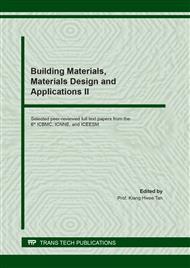[1]
C. Sevik, D. Çakır: Tailoring Storage Capacity and Ion Kinetics in Ti2CO2/ Graphene Heterostructures by Functionalization of Graphene. Phys. Rev. Appl. 2019, 12, 014001.
DOI: 10.1103/physrevapplied.12.014001
Google Scholar
[2]
I. Demiroglu, F.M. Peeters, O. Gülseren, D. Çakır, C. Sevik: Alkali Metal Intercalation in MXene/Graphene Heterostructures: A New Platform for Ion Battery Applications. J. Phys. Chem. Lett. 2019, 10, 727-734.
DOI: 10.1021/acs.jpclett.8b03056
Google Scholar
[3]
Y. Aierken, C. Sevik, O. Gülseren, F.M. Peeters, D. Çakır: Mxenes/Graphene Heterostructures for Li Battery Applications: A First Principles Study. J. Mater. Chem. A 2018, 6, 2337-2345.
DOI: 10.1039/c7ta09001c
Google Scholar
[4]
D. K. Bediako, M. Rezaee, H. Yoo, D. T. Larson, S.Y.F. Zhao, T. Taniguchi, K. Wantanabee, T. Brower-Thomas, E. Kaxiras, P. Kim: Heterointerface Effects in the Electrointercalation of Van Der Waals Heterostructures. Nature 2018, 558, 425-429.
DOI: 10.1038/s41586-018-0205-0
Google Scholar
[5]
J. Zhang, A. Yang, X. Wu, J. van de Groep, P. Tang, S. Li, B. Liu, F. Shi, J. Wan, Q. Li, et al: Reversible And Selective Ion Intercalation Through The Top Surface Of Few-Layer MoS2. Nat. Commun. 2018, 9, 5289.
DOI: 10.1038/s41467-018-07710-z
Google Scholar
[6]
J. Zhou, L. Wang, M. Yang, J. Wu, F. Chen, W. Huang, N. Han, H. Ye, F. Zhao, Y. Li, et al: Hierarchical VS2 Nanosheet Assemblies: A Universal Host Material for the Reversible Storage of Alkali Metal Ions. Adv. Mater. 2017, 29, 1702061.
DOI: 10.1002/adma.201702061
Google Scholar
[7]
D. Wang, Y. Gao, Y. Liu, D. Jin, Y. Gogotsi, X. Meng, F. Du, G. Chen, Y. Wei: First-Principles Calculations of Ti2N and Ti2NT2 (T = O, F, OH) Monolayers as Potential Anode Materials for Lithium-Ion Batteries and Beyond. J. Phys. Chem. C 2017, 121, 13025-13034.
DOI: 10.1021/acs.jpcc.7b03057
Google Scholar
[8]
Q. Li, Z. Yao, J. Wu, S. Mitra, S. Hao, T.S. Sahu, Y. Li, C. Wolverton, V.P. Dravid: Intermediate Phases in Sodium Intercalation Into Mos2 Nanosheets and Their Implications for Sodium-Ion Batteries. Nano Energy 2017, 38, 342-349.
DOI: 10.1016/j.nanoen.2017.05.055
Google Scholar
[9]
Y. Sun, D. Chen, Z. Liang: Liang, Z. Two-Dimensional Mxenes for Energy Storage and Conversion Applications. Mater. Today Energy 2017, 5, 22-36.
DOI: 10.1016/j.mtener.2017.04.008
Google Scholar
[10]
B. Anasori, M.R. Lukatskays, Y. Gogotsi: 2D Metal Carbides and Nitrides (Mxenes) for Energy Storage. Nat. Rev. Mater. 2017, 2, 16098.
DOI: 10.1038/natrevmats.2016.98
Google Scholar
[11]
P. Xiong, R. Ma, N. Sakai, L. Nurdiwijayanto, T. Sasaki: Unilamellar Metallic MoS2/Graphene Superlattice for Efficient Sodium Storage and Hydrogen Evolution. ACS Energy Lett. 2018, 3, 997-1005.
DOI: 10.1021/acsenergylett.8b00110
Google Scholar
[12]
G. Yuan, T. Bo, X. Qi, P. Liu, Z. Huang, B. Wang: Monolayer Zr2B2: A Promising Two-Dimensional Anode Material for Li-Ion Batteries. Applied Surface Science, 480, 448-453. doi:https://doi.org/10.1016/j.apsusc.2019, 2, 222.
DOI: 10.1016/j.apsusc.2019.02.222
Google Scholar
[13]
X. Ye, G. Zhu, J. Lin, C. Liu, X. Yan: Monolayer, Bilayer, and Heterostructure Arsenene as Potential Anode Materials for Magnesium-Ion Batteries: A First-Principles Study. J. Phys. Chem. C. 2019, 123, 15777-15786.
DOI: 10.1021/acs.jpcc.9b02399
Google Scholar
[14]
First Principles Methods Using CASTEP. Zeitschrift fuer Kristallographie 220(5-6) pp.567-570 (2005).
Google Scholar
[15]
J. P. Perdew, K. Burke, and M. Ernzerhof: Generalized Gradient Approximation Made Simple. Phys. Rev. Lett. 1996, 77, 3865.
DOI: 10.1103/physrevlett.77.3865
Google Scholar
[16]
G. Stefan, E. Stephan, and G. Lars: Effect of The Damping Function in Dispersion Corrected Density Functional Theory. J. Comput. Chem. 2011, 32, 1456.
Google Scholar
[17]
G. Wang, B. Xu, J. Shi, et al: New Insights Into Li Diffusion in Li–Si Alloys for Si Anode Materials: Role Of Si Microstructures[J]. Nanoscale, 2019, 11, 29.
DOI: 10.1039/c9nr03986d
Google Scholar


